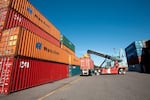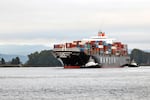
The Port of Portland's Terminal 6 entrance on June 11, 2024, in Portland, Ore. Terminal 6 is home to the states' only international shipping container service, a vital resource for Oregon farmers, ranchers and other exporters.
Kyra Buckley / OPB
On a sunny afternoon in June a dozen trucks line up on North Marine Drive in Portland, waiting to turn into marine Terminal 6 where they’ll drop off or load up large shipping containers.
It’s a fairly typical Tuesday at the Port of Portland’s shipping container terminal: Trucks show up with containers full of lentils, hay, animal feed, grass seed and other Oregon agricultural goods that are loaded onto large cargo ships and sent to other countries, then the rigs leave with containers carrying consumer goods from overseas points of origin, including in Asia.
It’s the only marine terminal in Oregon that handles international shipping containers. However, a previous labor feud coupled with the logistical challenges of navigating ships 100 miles upriver to a relatively small market have made Portland’s Terminal 6 less competitive in recent years. But it remains an important lifeline for small businesses and farmers throughout the region.
As Oregon legislators consider pouring millions of dollars into supporting the Port of Portland’s terminal operations, here are answers to a few basic questions:
Earlier this year the existence of a marine terminal with shipping container service was in jeopardy in Oregon. What happened?
The Port of Portland owns the marine terminal, but would prefer to have another company manage the operations. Officials thought they had found an operator, but in April told lawmakers the deal with the third party had fallen through. On top of that, they were facing a $30 million shortfall over the last few years, according to Port Director Curtis Robinhold, who also sits on the OPB board.
“Our losses began to really get deeper than we could manage on our own,” Robinhold said. “So we signaled publicly that we weren’t going to keep the doors open anymore — we just couldn’t bear these losses over more than the couple years that we had. We were losing about $12 [million] or $13 million a year, which is essentially all of our public money, so we were unable to do the other parts of our mission because this one piece of business was essentially eating all of the investment.”
However, the threat of closure was such a big deal that Gov. Tina Kotek stepped in to help keep it open.
In May, Kotek said she would include $35 million for the Port in her next budget, which legislators will consider in the 2025 session. Kotek is requesting $5 million from the legislative Emergency Board, which comes up for a decision this September. While lawmakers’ approval is not guaranteed, the announcement gave Port officials enough confidence to continue the current service.

A reach stacker unloads a container from a truck at Terminal 6. Terminal 6 is the Columbia River’s only deep-draft container terminal, supplying efficient, local access to international markets for regional businesses.
Courtesy of the Port of Portland
Why are shipping containers so important?
Oregon is one of the most trade-dependent states in the country, according to Teresa Carr with the Port of Portland’s trade and economic development division, particularly for the state’s farmers and ranchers who use containers to get their products to other states and countries.
“Imports and exports move through Terminal 6 every day, and those types of goods include anything from furniture to tires,” Carr said. “But the exports are really where we think that this is a value add to the shippers and to the Oregon community. And those are agricultural products — 40% of the agricultural products that are produced in Oregon are exported out of T6 to global markets.”
While the terminal may have lost money in recent years, Carr said it indirectly supports jobs in farming, ranching and other industries across the state.
What about the imports that come through Terminal 6?
All sorts of consumer goods land in Oregon from abroad, but only a small fraction of it stays in the state to end up on the shelves of stores like Fred Meyer. Instead, those goods are loaded onto a train or truck and sent to other states.
However, the real value of receiving imports at Terminal 6 is less about what’s inside the container and more about the containers themselves, according to longtime longshoreman Leal Sundet.
“Carriers don’t just willy-nilly send a bunch of containers to you if you want them,” Sundet, who also serves as secretary for the International Longshore and Warehouse Union Local 8, said. “They’re going to give you the containers for your exports if they’re bringing import in. When the import gets emptied, then that’s an empty container, and then you can put an export in it.”
Sundet said shipping companies make three to four times more money on a container bringing imports in than on one sending exports out.

Tugboats help a Hanjin container ship makes its way toward Terminal 6 at the Port of Portland.
Port of Portland
Do other ports besides Portland have shipping container service?
On the West Coast, ports in Long Beach, Oakland and Los Angeles in California as well as in the Seattle/Tacoma area in Washington also have shipping container service.
“The shipping container service is what puts a city or a port on a map in our industry,” Sundet said. “Containers drive everything.”
If the service disappears in Portland, farmers and ranchers in Oregon would likely have to pay a whole lot more to get their goods up to Tacoma or down to California — and that’s only if they can figure out the logistics, like securing a container.
However, while shipping container service is important to exporters in states like Oregon, it’s a small amount of what a port moves through it in terms of volume. Instead bulk commodities like petroleum, steel and lumber are the largest portion of freight moving through ports.
What accountability is there over institutions like ports — how are they governed and funded?
Every port is different, but they’re essentially quasi-government bodies focused on economic development.
The Port of Portland is governed by nine commissioners appointed by the governor. It has a budget of $450 million to operate multiple marine terminals, three airports and to sustainably develop industrial land. According to Robinhold, around $15 million comes from a property tax collected in the three counties the port operates in — Multnomah, Washington and Clackamas. Fees, revenue, grants and other funding sources make up the rest.
Also, there are rules dictating how that money can be spent, so funds earmarked for the aviation side can’t be moved to fund activity in the marine terminals.
What happens next with the shipping container service in Portland?
For now, the Port says it will continue shipping container service, but officials are still looking for a third party to manage operations.
Lawmakers also still need to approve Kotek’s funding proposals. The legislative Emergency Board is expected to vote on $5 million for the Port in September, and lawmakers will consider the remaining funds early next year.


